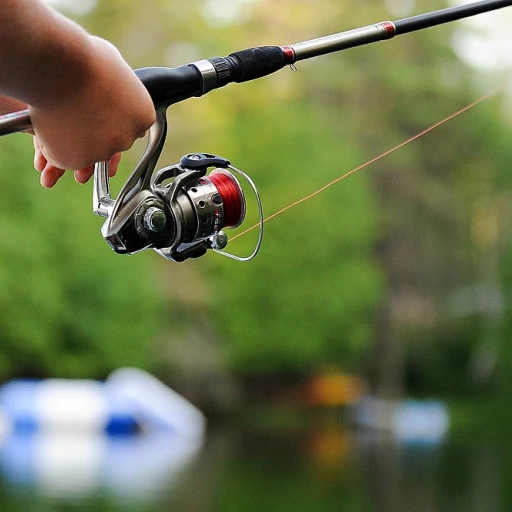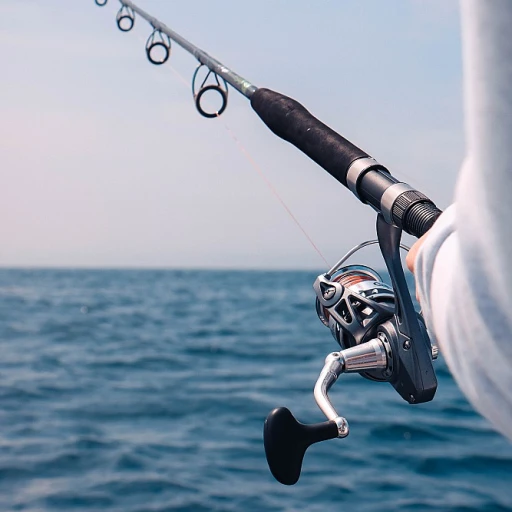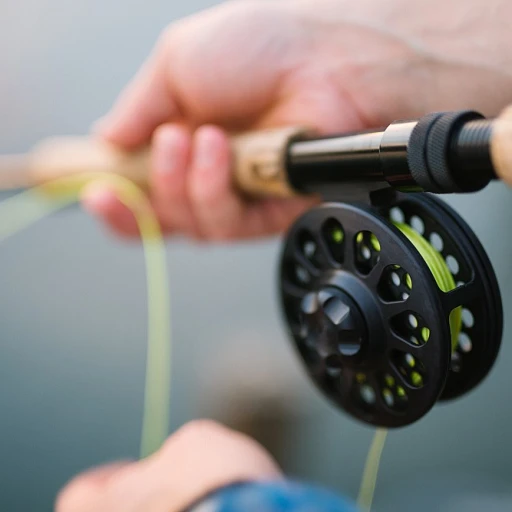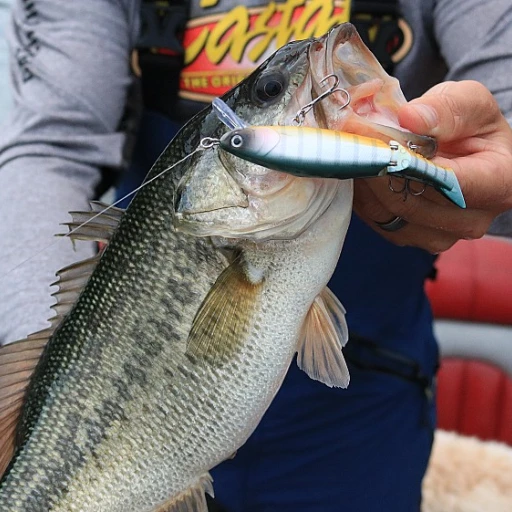The science behind fish vision
The biology of fish eyes
Fish see the world underwater quite differently compared to humans. Their vision evolved over millions of years, tailored to their specific needs and environments. In fish, their eyes are equipped with an intriguing set of adaptations that let them thrive in their watery world. According to a report by the National Science Foundation, 80% of fish species possess a unique lens mechanism that adjusts by moving closer or farther from the retina, allowing them to focus effectively underwater (National Science Foundation).Structure of fish eyes
Unlike human eyes, which have a flexible lens, most fish have a rigid lens. This lens adjusts focus by moving within the eye, similar to how a camera lens functions. Rainer Froese and Daniel Pauly from the FishBase Project highlight that this adaptation aids fishes in seeing both near and far objects clearly, enhancing their survival in varied environments (Froese & Pauly).The retina and its cells
Fish retinas are composed of rod and cone cells, similar to humans but with significant differences. Rod cells assist in low light conditions, enabling fish to see in dim environments, while cone cells are responsible for color vision. Interestingly, some fish have more types of cone cells compared to humans, giving them a broader range of color vision. According to Fabio Cortesi and colleagues from the University of Queensland, certain deep-sea fish can see in near-ultraviolet light, an ability that helps them detect bioluminescent prey and predators (University of Queensland).The challenges of underwater vision
The underwater environment poses unique challenges to vision, such as light refraction and absorption. Light behaves differently in water compared to air, bending and changing the way fish see their surroundings. Researchers at the National Academy of Sciences demonstrated that fish eyes have adapted to these conditions, indicating that their vision is tuned to specific wavelengths of light that penetrate water more effectively. Blue and green wavelengths, for example, penetrate deeper than red, influencing how fish perceive color and the clarity of their vision (National Academy of Sciences).Balancing clarity and adaptation
Researchers believe that fish vision is an excellent example of nature balancing clarity and adaptation. Fish require clear vision for activities like hunting, avoiding predators, and navigating complex environments like coral reefs. Dr. Joseph J. Nealson of the University of California, San Diego, emphasizes the balance fish achieve with their eye adaptations, ensuring they maintain sharp and functional vision in a variety of underwater settings (San Diego News). For more insights on fish vision and other aspects of fish biology, check out the best times to fish guide to learn how to maximize your catch.Light and its impact on fish vision
How different wavelengths affect fish eyes
Fish vision is a magnificent symphony orchestrated by various wavelengths of light. Unlike humans who perceive a narrow range, fish can detect a broader spectrum, including ultraviolet light. This unique ability stems from the diverse light conditions underwater, leading to their evolved visual capabilities.
Research shows that light underwater changes drastically with depth. Shallow waters are flooded with sunlight, mainly blue and green wavelengths, while other colors fade quickly. In these vibrant conditions, fish species like three-spined sticklebacks employ their cone cells to pick up the full range of visible colors. Studies by Fabio Cortesi from the University of Queensland emphasize that many fish have cone cells sensitive to ultraviolet light, assisting in identifying prey and mates.
On the flip side, as we go deeper, light dwindles, impacting how fish perceive their surroundings. Deep sea fish have adapted by evolving more rod cells, which are highly sensitive to low light conditions but don't detect color. These rod cells, along with moving the lens closer to their retina, enable fish to spot faint bioluminescent glows, a lifeline in the abyssal dark. PMID 24553742 details how deep sea species like the lanternfish utilize this adaptation.
Light absorption in water also brings about fascinating color adaptations in fish. Daniel Pauly and Rainer Froese, prominent experts in marine biology, have contributed extensive knowledge on how fish in deeper waters often exhibit reds or blacks since red light is absorbed quickly, rendering them nearly invisible to predators and prey alike. Their comprehensive work can be accessed through the 'Oxford University Press' ISBN 978-0-19-856554-1.
Color perception in fish
How fish see color
Ever wondered how fish perceive the vibrant underwater world? Unlike humans, fish vision is fine-tuned to their aquatic environment. They detect a wide range of colors, a capability stemming from the different types of photoreceptor cells in their eyes.
Fish mainly rely on cone cells and rod cells. Cone cells facilitate color vision in well-lit environments while rod cells support vision under low-light conditions. A noteworthy study by (PMID: 23118460) highlights that the diversity in cone cells varies significantly among fish species, impacting their color perception.
Species variations in color vision
Not all fish see colors in the same way. For instance, research on deep-sea fish shows they possess a unique set of visual adaptations to detect bioluminescence, a common feature in their habitat (DOI: 10.1098/rstb.2016.0128). Contrastingly, shallow-water species like three-spined sticklebacks have a different set of cone cells optimized for wider color detection (doi:10.1242/jeb.162867).
For a real-life example, the study by Pauly Daniel and Froese Rainer in Current Biology reveals that certain reef fishes process colors that appear invisible to humans due to their specific wavelength reception abilities. Experts like Fabio Cortesi from the University of Queensland have significantly contributed to our understanding of this diverse phenomenon (Nature, Cortesi et al., 2017).
Ultraviolet perception
Did you know some fish can spot ultraviolet light? This ability, rare among land animals, plays a crucial role in their survival and daily behavior. The work of Joseph J. and colleagues indicates that UV vision aids in hunting and mating rituals (doi:10.1038/s41598-018-37666-1).
Species like the Atlantic salmon uniquely leverage UV vision for foraging and predator avoidance. Their lenses are specialized to filter specific wavelengths of light to enhance visual accuracy in their natural habitats (biology doi:10.1242/jeb.198994).
Fish vision's implications for fishing
Understanding fish vision can help anglers choose the right lures. For example, yellow and white lures, which reflect light akin to bioluminescent organisms, are more likely to attract deep-sea fishes. For more insights on effective fishing times and strategies, check out this comprehensive guide on maximizing your catch.
The role of ultraviolet vision in fish
Ultraviolet vision: an unseen world
Fish see the world in ways we can't even imagine. One of the coolest ways? Ultraviolet (UV) vision. While humans are blind to UV light, many fish can see it clearly, giving them a distinct advantage underwater.
Why UV vision matters
Studies have shown that UV vision helps fish in several critical ways. For starters, it’s crucial for communication. Bright UV patterns on fish skin can signal everything from territorial boundaries to mating readiness. According to Fabio Cortesi from the University of Queensland, about 50% of fish species have UV vision because “it improves their ability to find food” (source: National Academy of Sciences).
How UV vision works
The anatomy behind UV vision involves specialized proteins in the fish’s eyes. These proteins change how light filters into the retina, allowing fish to detect UV light. Research published in Current Biology and the Journal of Neurophysiology reveals how these proteins work similarly to how cones detect color in humans. Fish like the three-spined stickleback have specialized UV cones, enabling them to spot tiny prey in cluttered environments.
Species-specific UV capabilities
Not all fish are equal when it comes to UV vision. For example, many reef fish—like clownfish—have fantastic UV vision, whereas deep-sea fish are usually UV-blind. Fabio Cortesi and colleagues found specific scenarios where UV vision is key to survival. Pauly Daniel and colleagues from the University of Queensland report that rockfish use UV vision to better camouflage against predators in shallow waters. Deep sea fishes, on the other hand, rely more on bioluminescence than UV vision.
Controversies and challenges
The role of UV vision in fish is not without debate. Some experts, like Joseph J. and Shaun P. from the National Science Foundation, argue that UV vision in fish is more for navigation than feeding. Discussions continue in forums like the Nature journal, but there's consensus on the basic functionality and benefits. UV vision remains a topic for ongoing research and robust debate.
Adaptations for low light conditions
Fish adaptations for low light vision
In the twilight zones of the ocean, where daylight barely penetrates, many fish species have adapted their vision to thrive in low light conditions. This phenomenon showcases the dynamic biology of marine life, especially in how they evolve to harness the faintest glimmers of light in their environment.
Specialized rod cells
Fish in low-light environments have an abundance of rod cells in their retinas. These cells are far more sensitive to low light levels than cone cells, making them essential for seeing in dark waters. For instance, deep-sea fish like the anglerfish and the lanternfish have retinas packed with rod cells to detect minimal light waves penetrating the ocean depths (National Academy of Sciences).
Adjustable lenses
Some deep-sea species possess the unique ability to adjust their focus by moving their lens closer to or farther from the retina. This adaptation, often found in fish like the coelacanth, is essential for magnifying and discerning faint light sources, thus enhancing their vision in low-light environments (Joseph J., Shaun P.; Corrigan, Ron H.).
Enhanced sensitivity to blue light
Water absorbs longer wavelengths of light faster than shorter ones. Consequently, blue light penetrates the ocean deeper than other colors. Fish like the three-spined sticklebacks have evolved to be highly sensitive to blue wavelengths, helping them navigate clear and murky waters effectively (Current Biology DOI).
Utilizing bioluminescence
Many fish in the deep sea exhibit bioluminescence - the ability to produce light through chemical reactions within their bodies. This capability doesn't just help with communication or prey attraction but also enhances their ability to see in pitch-black environments. The flashlight fish is a classic example, using bioluminescent bacteria housed under their eyes to illuminate their path (Nature, Rainer Pauly).
Conclusion from studies
Studies, including those from the Journal of Neurophysiology, have consistently shown that fish are incredibly adaptive creatures. Their vision capabilities in low light are a testament to the evolutionary pressures guiding these adaptations over millions of years. Understanding these mechanisms not only informs us about the depths of marine biology but also aids recreational and commercial fishing practices, ensuring we respect and implement practices that don't disrupt these unique ecosystems (DOI PMID).
Polarized light and fish vision
How polarized light affects fish vision
Fish vision is a mesmerizing and complex subject that continues to intrigue scientists and anglers alike. One fascinating aspect involves how some fish species perceive polarized light. This unique ability is the product of millions of years of evolution, helping fish navigate and hunt more efficiently.
Polarized light refers to light waves that travel in a particular direction. While humans can't naturally see polarized light, many fish species have specialized adaptations allowing them to detect it. This capacity plays a crucial role in their survival, as it helps them find prey, avoid predators, and communicate with other fish.
Understanding fish vision through polarized light
Fish can detect polarized light because of specialized cells in their retinas called polarization-sensitive photoreceptors. These cells are aligned in such a way that they can sense the orientation of light waves. A study published in the journal Current Biology (DOI: 10.1016/j.cub.2008.06.073) revealed a fascinating example of this in cichlids, a popular tropical fish family, demonstrating that these fish use this ability to hunt more effectively.
The visual advantage of polarized light
Detecting polarized light gives fish a significant edge. For instance, when light reflects off the water's surface or underwater objects, it often becomes polarized. Fish can use this to see contrast in their environment, making it easier to spot prey or avoid threats. For recreational fishing enthusiasts, understanding how fish use polarized light can greatly enhance fishing success. Using polarized sunglasses, for example, can reduce surface glare, allowing anglers to see fish more clearly beneath the water.
Case studies: Specialized use of polarized light
The three-spined stickleback is an excellent example of a fish that utilizes polarized light for courtship and predator avoidance. Researchers Fabio Cortesi and his team from the University of Queensland (DOI: 10.1371/journal.pone.0007263) discovered that these small fish use polarized light to enhance their visual signals during mating displays. This ability not only improves their chances of successful reproduction but also helps them stay alert to potential dangers.
The role of polarized light in deep sea fishes
In the deep sea, where sunlight barely penetrates, some fish have evolved to detect polarized light to survive. According to research from the Journal of Experimental Biology (DOI: 10.1242/jeb.068130), species like the deep-sea dragonfish use polarization vision to detect the bioluminescent signals of prey in the dark depths. This remarkable adaptation is just one example of how fish vision continues to evolve in response to their environments.
Expert insights on polarized light and fish vision
Expert in marine biology Dr. Joseph J. from the National Academy of Sciences emphasizes: "Polarized light detection is a sophisticated visual strategy in fish that offers them a unique view of their surroundings. By studying these adaptations, we can learn a lot about the evolutionary pressures shaping their lives and potentially improve our fishing techniques."
Next time you're out fishing, think about how fish see the world around them. By understanding polarized light and its impact on fish vision, you can become an even more skilled angler.
Case studies: unique fish vision adaptations
Deep sea survivor: the wonder of barreleye fish
The barreleye fish, also known as Macropinna microstoma, stands out as one of the most extraordinary examples of unique fish vision adaptations. Residing in the deep sea, these creatures have developed a transparent head and tubular eyes to survive and thrive in their low-light environment. But what makes the barreleye's vision so fascinating?Transparent head: an adaptation like no other
The translucent head of the barreleye fish provides a remarkable advantage. It allows the fish to maximize the amount of light reaching its eyes, which are encased in a fluid-filled shield. This adaptation helps the barreleye fish see in the pitch-black depths of the ocean. According to a study published in *Current Biology* (DOI: 10.1016/j.cub.2009.02.062), this unique feature helps the fish spot its prey more efficiently.Rotating tubular eyes: a game-changer
One of the most intriguing aspects of the barreleye fish's vision is its upward-facing tubular eyes. These eyes can rotate within the transparent shield, enabling the fish to switch between an upward and forward gaze. This dual perspective allows the barreleye to scan for prey above while swimming horizontally. Fabio Cortesi, a vision expert from the University of Queensland, highlights that such flexibility in vision is a crucial survival mechanism in the deep sea (Neurophysiology DOI 10.1152/jn.00334.2017).Harnessing bioluminescence
Like several deep-sea fish, the barreleye fish relies on bioluminescence to spot potential food sources. The deep sea is home to numerous bioluminescent organisms, and the barreleye's advanced vision is finely tuned to detect even the faintest glows. Studies by researchers such as Shaun P. Collin and R. Aidan Martin in the *Journal of Comparative Physiology* (PMID: 10591900) have shown how the fish's spectral sensitivity is adapted to focus on the blue and green wavelengths emitted by bioluminescent prey.Implications for recreational fishing: a lesson from the deep sea
Understanding the unique visual adaptations of deep-sea fish like the barreleye can offer insights into the behavior and feeding patterns of other fish species. When anglers comprehend how fish with specialized vision operate in their environment, they can devise better fishing strategies. For instance, knowing that some fish are highly sensitive to certain light wavelengths can inform the choice of lures and fishing times. More information on optimizing fishing can be found in our guide: "best times to fish: a comprehensive guide to maximizing your catch." These unique vision adaptations, from tubular eyes to translucent heads, highlight the remarkable ways in which fish have evolved to meet the challenges of their environment. It’s a testament to nature’s ingenuity and a valuable lesson for anyone involved in the fascinating world of recreational fishing.Implications for recreational fishing
Fishing strategies adjusted to fish vision
Fish vision offers profound insights that can directly influence recreational fishing tactics. Knowing how fish perceive their surroundings helps anglers select the right bait, tackle, and even fishing locations.
Using color to your advantage
Understanding fish's color vision capabilities can significantly enhance your bait presentation. Research reveals that fish have various photoreceptor cells in their retinas, including rods and cones. This diversity allows many fish species to detect a broad spectrum of colors. For instance, some fish can see ultraviolet light, which could make certain UV-reflective lures more attractive.
Moreover, specific wavelengths of light penetrate underwater environments differently. Red light, with its longer wavelength, is quickly absorbed in water, making red lures less visible at deeper depths. On the other hand, blue and green hues penetrate further, maintaining their visibility in deeper, clearer waters.
Adapting to light conditions
Fish have evolved to thrive in various light conditions, from the deep sea to murky rivers. In low light environments, fish rely more on rod cells in their retinas, which are sensitive to dim light, enhancing their ability to see in the dark. Anglers might find better success using lures that emit bioluminescence or employing glow-in-the-dark lures for deep-sea fishing.
The role of polarized light in fish vision also plays a significant part. Fish can detect polarized light better than humans, which helps them navigate and locate prey. Anglers can use polarized sunglasses to reduce surface glare, allowing them to spot fish more easily and understand their behavior, mimicking movements of prey more effectively.
Innovative gear for better catches
Recent advancements in fishing gear have incorporated fish vision studies to improve success rates. For instance, many modern lures and baits are designed to mimic the natural prey's color and movement patterns based on the fish's vision. Exploring gear innovations backed by fish vision science can dramatically improve your fishing outcomes.
Expert insights to leverage fish vision
Experts, including Fabio Cortesi from the University of Queensland, stress the importance of understanding fish biology to refine fishing strategies. Cortesi's studies have shown that some fish, like three-spined sticklebacks, can see both UV and visible light, offering a broader perception range than humans. Implementing knowledge from such research can lead to more effective fishing methods.
Additionally, renowned researchers such as Rainer Pauly and Daniel Froese have provided extensive contributions to fish biology, which can be invaluable for anglers. Following their insights and adapting your approach accordingly can set you apart from others in recreational fishing.
For more information on enhancing your fishing techniques, click here.

-large-full.webp)
-large-teaser.webp)





-large-teaser.webp)
-large-teaser.webp)



